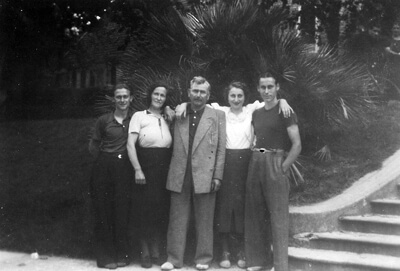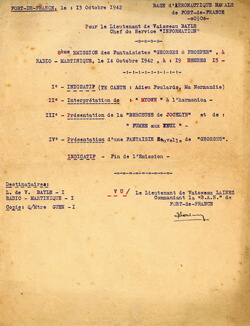
JEAN JOSEPH GUEN was born on January 20, 1922 in Bois-Colombes, in the Paris region. His mother, Francine Chauvin, worked as a dressmaker. His father, Théodore Guen, was a railway worker. He has one brother, Yves, who is 2 years older and one younger sister, Madeleine, born in 1923. He spent his childhood in Conflans-Sainte-Honorine.
Upon the completion of his certificate of primary education, Jean entered an outdoor workshop-school in Andrésy in October 1934, like his brother one year earlier, in order to follow introductory courses in various manual labours. Few months after joining this school, he decided to specialize into mechanical fitting and learned about the basic skills of the craft : « I'm a fitter. I can work at a fiftieth of millimeter to make dovetails. » In June 1936, he obtained his NVQ in fitting.
A DEFINING period for Jean's professional future occurred during his stay in the outdoor school. A classmate confided to him that he used to pass the time listening to music with a crystal radio receiver made by his father. He showed to Jean the device, which broadcasted a Radio-Luxembourg program, explaining that the speaker was several hundreds of kilometres away from them. Jean did not even know what radio was and believed he was seeing a wonder, « a cleric thing » in his words. « I looked how it was made inside, I was passionate about it, this was love at first sight ! » Fascinated by this discovery, he quickly developed a passion for radio broadcasting and took up construction of his first crystal radio receivers.
The extent of that passion encouraged him to quit his school in July 1936 in order to work as an electrical assembler in Raylia radio manufacturer located at 18, rue Ramey in Paris. There, he learned how to build and repair radio sets. Having a desire to learn more, he got, on the advice of an engineer workmate, the book « Pratique et Théorie de la T.S.F. » by Paul Berché, a manual of reference about radioelectric methods. Then, he built his first shortwave transceiver operating in the 40-meter band and became amateur radio using the callsign F3JG. « My parents were proud of me but did not manifest it. »
In November 1937, Jean was hired by the Société Anonyme Des Industries Radioélectriques (SADIR), specialized in the manufacturing of radio devices for the French Air Force and the Navy, as an electrical assembler in the company's workshops located in Puteaux.
ON 2 OCTOBER 1938, the 16-year-old Jean enrolled the apprentice sailor school of Brest in French Brittany, based on the training ship L'Armorique. He pursued a course preparing for careers in the National Navy until July 1939.
Jean obtained a radio operator elementary certificate at the wireless school of Lorient in February 1940, followed by an aircraft radio operator certificate at the naval air station of Hourtin in Aquitaine in May of the same year. « After leaving the military, I could have been an officer in the Merchant navy or at Air France [laughs]. »
By this time, the war was raging. A tragic event has left marks on the young 18-year-old sailor. On 28 May 1940, at the behest of his superiors, Jean began his shift at eight o'clock in the morning on the bridge of the passenger ship M/S Brazza, sailing from Bordeaux to Pointe-Noire in the Republic of the Congo with a stopover at the port of Casablanca in Marocco. At 8:25 in the morning, a German torpedo struck the starboard side of the ship which sunk in a matter of minutes. Jean managed to save his life but lost many of his comrades.
In early 1941, Jean joined the Navy in the French Antilles in order to serve as an aircraft radio operator. He arrived at Fort-de-France in Martinique in February 1941. Later, he learned that his presence was intended to keep gold stock of the Bank of France from falling into German hands.

In 1942, Jean used to write and perform plays in the company of his friend Georges Godebert, met at the wireless school, future artistic director at Radio Guadeloupe and producer of the radio show Le Petit Conservatoire de la chanson. Both hosted a series of radio programs on Radio Martinique under the pseudonyms Georges and Prosper. During the broadcasts, Jean alias Prosper recited poems, sang or played harmonica. « I was the best harmonicist in Martinique... I was the only one. » Jean says in fun. « I played Rimsky-Korsakov's Hindu Song, I used to play classical music, jazz as well. I played the Bolero by Ravel, Tiger Rag by Duke Ellington... Then I described the feeling I had. »
In June 1942, Jean took part to the West Indian Ersatz Goods Exhibition that intended to remedy universal shortage. For this event, he proposed on his booth a portable transmitter, made from recycled materials. « At one point, I was testing it with the vessel where my mates were, 200 meters away, in their dormitory. I was myself at the base, in the radio control hub. One of my friends played mandolin. I placed a contact microphone on it, plugged into my small transmitter. And up there, they could hear the mandolin. Unintentionally, I built my first radioelectric guitar [laughs] ! The contact microphone could be a chip of carbon microphone for telephones, simply an earphone, or the quartz from record player stylus. »
Jean left French Antilles in October 1943. One year later, while serving at the naval air station in Agadir, he was promoted to Petty Officer. Then, on his return to mainland France in November 1944, he was employed as repairer of radio devices and detection systems into the Carrier Battle Group n°2 operating on the Atlantic front.
Once demobilized in August 1945, Jean was hired as a technical officer by the Société Indépendante de télégraphie sans Fil (SIF) situated in Malakoff.